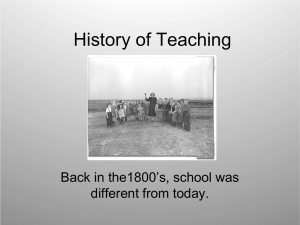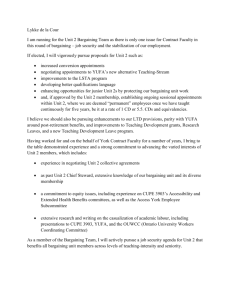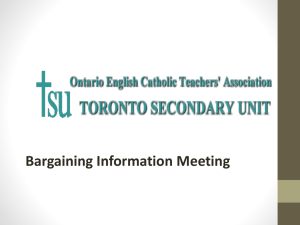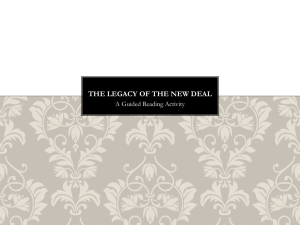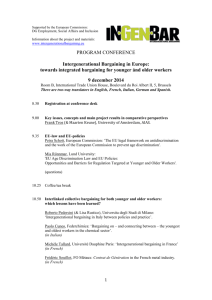IR SShort answer
advertisement
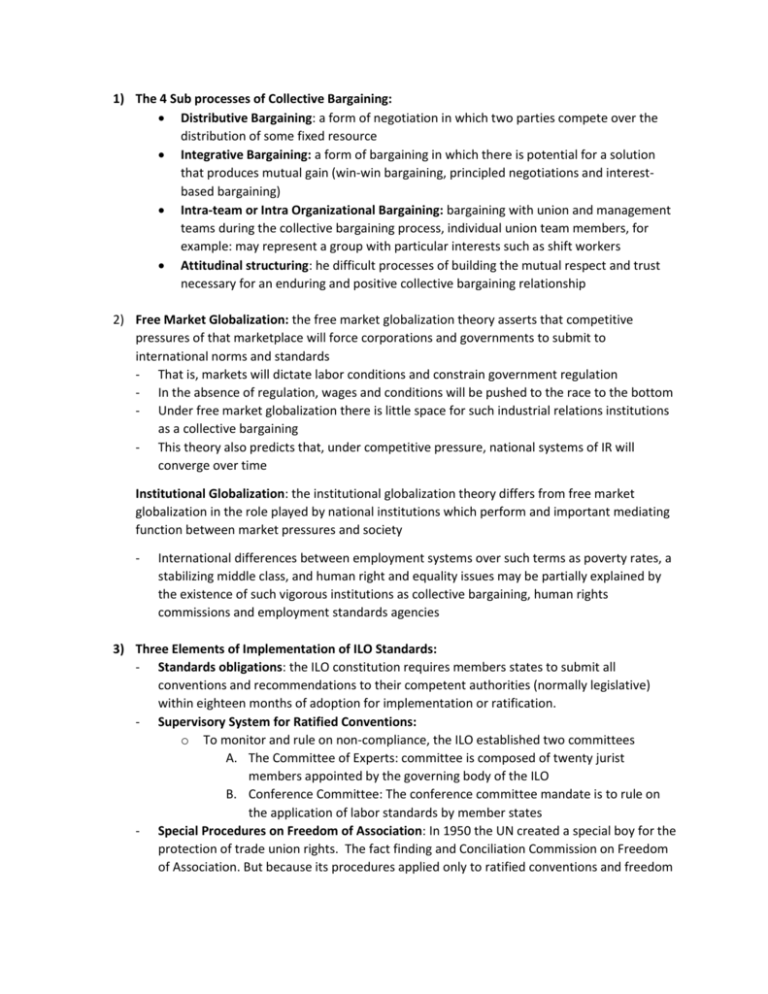
1) The 4 Sub processes of Collective Bargaining: Distributive Bargaining: a form of negotiation in which two parties compete over the distribution of some fixed resource Integrative Bargaining: a form of bargaining in which there is potential for a solution that produces mutual gain (win-win bargaining, principled negotiations and interestbased bargaining) Intra-team or Intra Organizational Bargaining: bargaining with union and management teams during the collective bargaining process, individual union team members, for example: may represent a group with particular interests such as shift workers Attitudinal structuring: he difficult processes of building the mutual respect and trust necessary for an enduring and positive collective bargaining relationship 2) Free Market Globalization: the free market globalization theory asserts that competitive pressures of that marketplace will force corporations and governments to submit to international norms and standards - That is, markets will dictate labor conditions and constrain government regulation - In the absence of regulation, wages and conditions will be pushed to the race to the bottom - Under free market globalization there is little space for such industrial relations institutions as a collective bargaining - This theory also predicts that, under competitive pressure, national systems of IR will converge over time Institutional Globalization: the institutional globalization theory differs from free market globalization in the role played by national institutions which perform and important mediating function between market pressures and society - International differences between employment systems over such terms as poverty rates, a stabilizing middle class, and human right and equality issues may be partially explained by the existence of such vigorous institutions as collective bargaining, human rights commissions and employment standards agencies 3) Three Elements of Implementation of ILO Standards: - Standards obligations: the ILO constitution requires members states to submit all conventions and recommendations to their competent authorities (normally legislative) within eighteen months of adoption for implementation or ratification. - Supervisory System for Ratified Conventions: o To monitor and rule on non-compliance, the ILO established two committees A. The Committee of Experts: committee is composed of twenty jurist members appointed by the governing body of the ILO B. Conference Committee: The conference committee mandate is to rule on the application of labor standards by member states - Special Procedures on Freedom of Association: In 1950 the UN created a special boy for the protection of trade union rights. The fact finding and Conciliation Commission on Freedom of Association. But because its procedures applied only to ratified conventions and freedom of association issues usually involved question of fact, not law, the ILO created a specific committee CFA. 4) Describe Two High- Performance models that have emerged in Canada: A. Salaried Model: White Collar employees (professionals, technical, office staff) Broad job functions Compensation: based on merit/performance, job security B. Hourly: Blue Collar Usually unionized work places Specific job tasks Seniority based human resource practices (promotion, pay) Hourly model ties labor to production in that the labor force adjusts to supply and demand of the product Limited security EXCEPT seniority allows more senior employees more job protection from job loss 5) Interest Based Bargaining: is cooperative form of bargaining in which the parties focus more on interests of the parties and not on the exaggerated positions. Also called Principle, Integrative, cooperative, positive sum or collaborative negotiations IBB Assumptions (4): - Both labor and management can win Each can assist the other to win Open discussions expand areas of mutual interests Decision making is based more on standards for evaluating options than on power 6) Types of Clauses: - The rights of parties: the rights of the union, employers and employees - The organization of work: this includes provision concerning how work is organized and distributed - Labor Relations Process: these clauses concern the grievance procedure, arbitration and any language about joint committees. Collective agreement language concerning joint committees will often examine issues related to working conditions/environment, contracting out and technological changes - Education, training, and development: language in this grouping can include issues concerning training leave, required/provided training, financial assistance for training, and apprenticeship programs - Working Conditions: this is perhaps the broadest grouping of clauses, including issues related to hours of work/work schedules, overtime, pay and benefits, job security, termination, corrective action/progressive discipline, part time work 7) Three Common Theories of Strikes: While these researchers focused on unions striking, w believe that managers may lock out employees for many of the same theoretical reasons 1) Accident (or Hicks) Theory: is basd on the assumption that strikes represent accidents - Rational negotiators would seek to avoid strikes and lockouts in order to avoid their high costs - Theory states that strikes should be unexpected and that when they do occur they are the result of errors made at the bargaining table. Misunderstanding bargaining, or mismatches between expectations of the bargaining team and the group they represent 2) Total Joint Cost Theory: argues that strikes are more likely to occur when the cost of the strike is relatively low for both parties - If the cost is low to one party but high for another, a strike may not be likely given the clear power imbalance - The difference in cost of the strike to one party, relative to the other, results in a difference in bargaining power 5) Asymmetric Information Theory: is grounded in the assumption that parties may strike or lockout as a way to see if the other side is bluffing. - In doing so, the parties gather more information about the claims of the other party, information that would not be easily accessible in other ways. 8) FIVE COMMON CAUSES OF STRIKES: 1) Catalysts: strikes sparked by a single trigger event 2) Isolated Homogeneous Groups: intact groups of similar workers, particularly if they are in unpleasant jobs, may be more prone to strikes 3) Management Indifference or Unresolved Grievance: management (low level management especially) show indifference to worker complaints sparks a strike 4) Frustration-Aggression: workers with feelings of work frustration, alienation, or dissatisfaction will naturally seek to improve the situation through their involvement in union action and strikes 5)Economic Factors: The general trend shows that strikes are more common when the economy is doing well and unemployment is low 6)Intra-organizational factors: intra-organizational misalignment can reduce power at the bargaining table, so too can it result in strike activity 9) Three (3) Elements of Compensation: - Base pay: the portion of a works pay that is based on time worked and not based on performance or output - Performance pay: represenats the portion of an employees pay provided only if certain, specific targets are achieved - Indirect Pay: includes anything that the employer pays for that is not part of employees base pay or performance pay 10) Marshall’s Condition of Elasticity: 4 conditions that determine the inelasticity of demand for labor and the wage- employment tradeoff, unions are more powerful WHEN: 1) Demand for product or service is inelastic 2) Labor is not easily substituted 3) Supply of substitutes in inelastic (price of substitutes rises as more demanded) 4) Labor is a small proportion of total costs How do they relate to the power of unions? - Factors 1&2 would appear to give public sector unions more power Factor 3: not important when explaining public-private differences in elasticity’s Factor 4: serves to reduce union power in public sector In the end the outcome is indeterminate. Factors 1 & 2 seem to increase union power, 3rd factor is neutral and the last reduces union power
